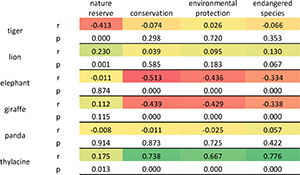Can Google Trends data confirm the need for charismatic species to generate interest in conservation?
Michael Zieger A B and Steffen Springer A
A B and Steffen Springer A
A SRH Wald-Klinikum Gera GmbH, Gera, Germany.
B Corresponding author. Email: Michael_Zieger@icloud.com
Pacific Conservation Biology - https://doi.org/10.1071/PC20090
Submitted: 11 November 2020 Accepted: 3 January 2021 Published online: 21 January 2021
Abstract
In nature conservation and environmental protection, there is the thesis that charismatic flagship species generate a high level of public interest that can be used for nature conservation efforts. Among other things, Google Trends has already been introduced to analyse nature conservation issues. In this study, interest in selected charismatic species were compared with the terms ‘nature reserve’, ‘conservation’, ‘environmental protection’, and ‘endangered species’ from the field of nature and environmental protection in three selected English-speaking countries and worldwide by using Google Trends. Although some individual, selected terms, e.g. ‘panda’ or ‘thylacine’, could be valuable ambassadors for nature and environmental protection in certain regions, a more general benefit or need for charismatic species to generate interest in conservation and environmental issues was not clearly demonstrated in this study.

Keywords: charismatic species, conservation, conservation biology, Google Trends.
References
Albert, C., Luque, G. M., and Courchamp, F. (2018). The twenty most charismatic species. PloS ONE 13, e0199149.| The twenty most charismatic species.Crossref | GoogleScholarGoogle Scholar | 29985962PubMed |
Brambilla, M., Gustin, M., and Celada, C. (2013). Species appeal predicts conservation status. Biological Conservation 160, 209–213.
| Species appeal predicts conservation status.Crossref | GoogleScholarGoogle Scholar |
Cooper, M. W., Di Minin, E., Hausmann, A., Qin, S., Schwartz, A. J., and Correia, R. A. (2019). Developing a global indicator for Aichi Target 1 by merging online data sources to measure biodiversity awareness and engagement. Biological Conservation 230, 29–36.
| Developing a global indicator for Aichi Target 1 by merging online data sources to measure biodiversity awareness and engagement.Crossref | GoogleScholarGoogle Scholar |
Courchamp, F., Jaric, I., Albert, C., Meinard, Y., Ripple, W. J., and Chapron, G. (2018). The paradoxical extinction of the most charismatic animals. PLoS Biology 16, e2003997.
| The paradoxical extinction of the most charismatic animals.Crossref | GoogleScholarGoogle Scholar | 29649205PubMed |
Dietzel, M. A. (2016). Sentiment-based predictions of housing market turning points with Google Trends. International Journal of Housing Markets and Analysis 9, 108–136.
| Sentiment-based predictions of housing market turning points with Google Trends.Crossref | GoogleScholarGoogle Scholar |
Ducarme, F., Luque, G. M., and Courchamp, F. (2013). What are “charismatic species” for conservation biologists. BioSciences Master Reviews 10, 1–8.
Durmuşoğlu, Z. D. U. (2017). Using Google trends data to assess public understanding on the environmental risks. Human and Ecological Risk Assessment 23, 1968–1977.
| Using Google trends data to assess public understanding on the environmental risks.Crossref | GoogleScholarGoogle Scholar |
Eichenauer, V., Indergand, R., Martínez, I. Z., & Sax, C. (2020). Constructing daily economic sentiment indices based on Google Trends. KOF Working Papers, 484.
Ficetola, G. F. (2013). Is interest toward the environment really declining? The complexity of analysing trends using internet search data. Biodiversity and Conservation 22, 2983–2988.
| Is interest toward the environment really declining? The complexity of analysing trends using internet search data.Crossref | GoogleScholarGoogle Scholar |
Home, R., Keller, C., Nagel, P., Bauer, N., and Hunziker, M. (2009). Selection criteria for flagship species by conservation organizations. Environmental Conservation 36, 139–148.
| Selection criteria for flagship species by conservation organizations.Crossref | GoogleScholarGoogle Scholar |
Kontoleon, A., and Swanson, T. (2003). The willingness to pay for property rights for the giant panda: can a charismatic species be an instrument for nature conservation? Land Economics 79, 483–499.
| The willingness to pay for property rights for the giant panda: can a charismatic species be an instrument for nature conservation?Crossref | GoogleScholarGoogle Scholar |
Nghiem, L. T., Papworth, S. K., Lim, F. K., and Carrasco, L. R. (2016). Analysis of the capacity of Google Trends to measure interest in conservation topics and the role of online news. PloS ONE 11, e0152802.
| Analysis of the capacity of Google Trends to measure interest in conservation topics and the role of online news.Crossref | GoogleScholarGoogle Scholar |
Proulx, R., Massicotte, P., and Pépino, M. (2014). Googling trends in conservation biology. Conservation Biology 28, 44–51.
| Googling trends in conservation biology.Crossref | GoogleScholarGoogle Scholar | 24033767PubMed |
Troumbis, A. Y. (2017). Google Trends and cycles of public interest in biodiversity: the animal spirits effect. Biodiversity and Conservation 26, 3421–3443.
| Google Trends and cycles of public interest in biodiversity: the animal spirits effect.Crossref | GoogleScholarGoogle Scholar |
Troumbis, A. Y., and Iosifidis, S. (2020). A decade of Google Trends-based conservation culturomics research: A critical evaluation of an evolving epistemology. Biological Conservation 248, 108647.
| A decade of Google Trends-based conservation culturomics research: A critical evaluation of an evolving epistemology.Crossref | GoogleScholarGoogle Scholar |
Zieger, M., and Springer, S. (2020). Thylacine and Tasmanian devil: between hope and reality – a lesson to be learnt from Google Trends search data. Australian Journal of Zoology , .
| Thylacine and Tasmanian devil: between hope and reality – a lesson to be learnt from Google Trends search data.Crossref | GoogleScholarGoogle Scholar |


